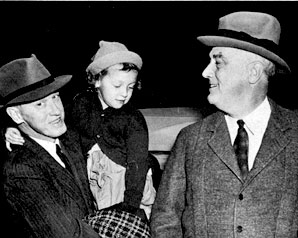This Week in History:
May 20-26, 1933
Harry Hopkins Begins His Leadership
of the Federal Emergency Relief Administration
May 2012
|
|
On May 12, 1933, President Franklin Delano Roosevelt signed into law the bill establishing the Federal Emergency Relief Administration (FERA), the first mass public assistance program put into effect his Administration. The bill authorized the spending of $500 million, divided into two portions: half to be spent as matching funds for localities, and the other half for distribution to locations which could not meet the matching requirement. The aim was to immediately make a dent in mass unemployment, starvation, and other such widespread suffering.
The critical decision which the President took, however, was not simply the structure of the program, but who would administer it. On May 19, he decided to tap Harry Hopkins, then the chairman of the New York State Temporary Emergency Relief Administration, which had been established by Roosevelt himself when he was Governor of the state. The President overrode the objections of New York Governor Herbert Lehman, and ordered Hopkins to report to Washington, D.C. on May 22.
Hopkins was a career social worker, who had come from a small town in Iowa. But he had none of that squishy "how do you feel?" quality that one might associate with a social worker today. Hopkins was the kind of person who immediately took charge, assumed responsibility, gave orders, and acted. He had that same voluntarist spirit that inspired the President to act so decisively to save the republic—a spirit that led Hopkins to become an increasingly trusted ally of Roosevelt's in the Administration.
Thus, the FERA administrator threw together a staff within 48 hours. He immediately began collecting information, and alerted the Governors of the 48 states that they should set up state organizations for him to coordinate with. Within that same period, Hopkins sent money to seven states. In fact, according to one source, he spent over $5 million in his first two hours in his new job, working from a makeshift office in the halls of the Reconstruction Finance Corporation, which provided some of the funding.
While FERA's mandate included direct relief, including the traditional "means test" whereby individuals had to prove their indigence in order to receive aid, Hopkins was much more disposed to provide work relief projects. He realized that a vast proportion of those who needed help, had been thrown out of work, and, for the sake of their own self-respect, wanted to work.
Thus, Hopkins moved as rapidly as possible to set up the Civil Works Administration (CWA), which was a totally Federal agency, able to employ workers directly. The FERA Administration got permission from the President to establish the CWA in late October 1933. The agency's mandate, in Hopkins' view, was to employ 4 million people over the winter. The agency devoted half its funds to employing people from the relief rolls, and half to others who needed work. The CWA paid minimum wage, not "relief."
As the CWA developed, it became a massive public works employer. Hopkins improvised, using much of his FERA staff for CWA work, including generating the projects which needed to get done. By mid-January 1934, the CWA had employed 4,230,000 persons.
And what did these people do? As opposed to the Public Works Administration, which was involved in building major dam projects, for example, they concentrated on medium and small-sized projects. According to Arthur Schlesinger, Jr., about a third of them worked on roads and highways. The next largest group of projects involved building or improving schools, including playgrounds. At least 50,000 teachers were provided to rural schools which could not otherwise afford to pay them in the midst of the Depression. In addition, the CWA workers built 500 airports, developed parks, cleared waterways and sewers, and even employed writers and artists.
For a fuller report on this aspect of Roosevelt's recovery program, see LaRouche in 2004's Special Report, "The End of a Delusion." It is also available in EIR magazine, Vol. 29, No. 17, cover date May 3, 2002.
We can learn from this and organize for the Emergency Resolution that LaRouche PAC and EIR have called for. The immediate reenactment of Glass Steagall, the reestablishment of the US Constitutional Credit system, and the NAWAPA 21 will create today at least 4 million jobs immediately, with 2 million to follow shortly.
The original article was published in the EIR Online’s Electronic Intelligence Weekly, as part of an ongoing series on history, with a special emphasis on American history. We are reprinting and updating these articles now to assist our readers in understanding of the American System of Economy.

